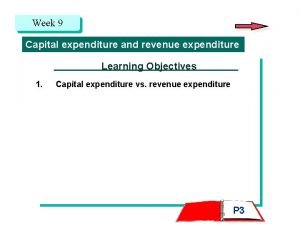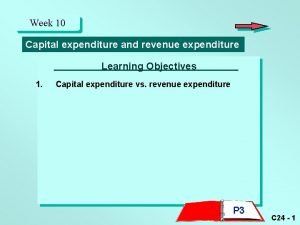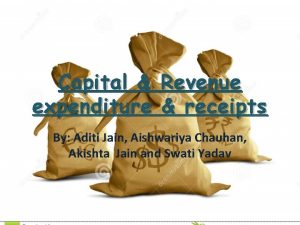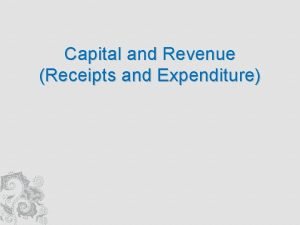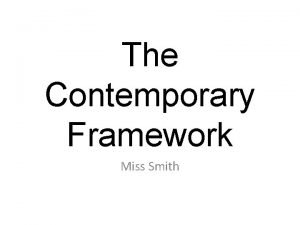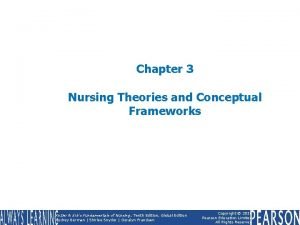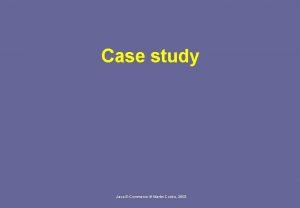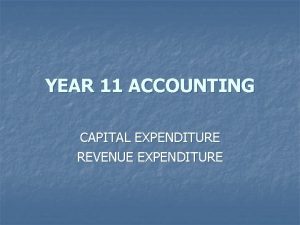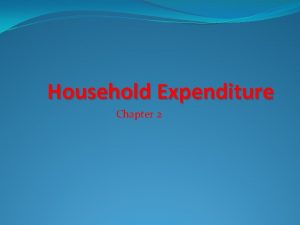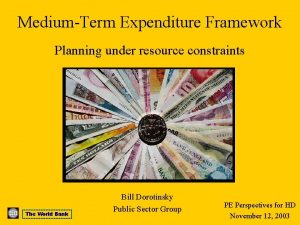Mediumterm Expenditure Frameworks Why do they work in












- Slides: 12

Medium-term Expenditure Frameworks: Why do they work in advanced countries? (and why do they sometimes fail? ) Richard Hughes Public Financial Management I Fiscal Affairs Department 2 October 2008

OUTLINE I. Objectives of MTEFs II. Advanced country MTEF models III. 5 keys to advanced country success with MTEFs IV. Some thoughts on why MTEFs sometimes fail V. Implications for MTEF design in L/MICs 2

I. Objectives of MTEFs: MTEFs are generally designed with three broad aims in mind: 1. Instill greater discipline over advance commitments of public money by constraining budget appropriation and execution in future years to levels consistent with the Government’s medium-term fiscal and sectoral objectives. (Finance Ministries and IMF) 2. Facilitate a more strategic prioritization of expenditure by abstracting from the immediate pressures and legal constraints that impinge upon the annual budget process. (Planning Ministries, World Bank and Donors) 3. Encourage more efficient inter-temporal planning of expenditure by providing greater transparency to budget holders about their likely future resources. (Sectoral Ministries and Donors) But there is a fundamental tension between these three objectives which is reflected in the range of advanced country models… 3

II. Advanced country MTEFs: Models very based on coverage, detail, time horizon & discipline COVERAGE Soc Sec Finland Some Debt Interest No Local Govt No % of public spending 36% LEVEL OF DETAIL* Total Spending DISCIPLINE TIME HORIZON Rolling or Fixed Frequency of Revision 4 4 fixed Every 4 years 13 Ministries 4 Sectors Netherlands Yes No Some 80% United Kingdom No No Some 59% 25 Depts 3 2 fixed + 1 rolling Every 2 years France No Yes No 31% 35 Missions 3 2 fixed + 1 rolling Every 2 years 3 2 fixed + 1 rolling Every year 3 Rolling Every year 3 to 5 Rolling Every year Sweden Yes No Some 64% 31 Subsectors Total Spending 27 Areas Australia Yes Yes 100% Uganda Yes Yes 100% 20 Depts 267 Progs 16 Sectors 162 Progs * Bold 4 = Fixed multi-year ceiling Italics = Indicative multi-year projection

III. Key to Success # 1: Model Design They don’t try to do everything Time Horizon, Discipline, Coverage and Detail of 5 Multi-Year Budgeting Models 5

Key to Success # 2: Historical Origins Most MTEFs were forged in fiscal adversity… UK introduces Spending Reviews Finland introduces Expenditure Ceilings Netherlands introduces Expenditure Ceilings Sweden introduces Expenditure Ceilings France introduces Multi-year Budget Canada introduces Expenditure Management System …but were introduced to maintain discipline AFTER the public finances had turned the corner. 6

Key to Success # 3 : Budgetary Foundations They start with a credible annual budget Expenditure Forecast Accuracy UNITED KINGDOM VS. TANZANIA UK’s 1 year-ahead forecasting error for public expenditure is about 1%. . . …which is 1/7 th the 1 year-ahead forecasting error for public expenditure in Tanzania. UK’s 5 year-ahead forecasting error for public expenditure is 5. 2%. . . …which is still lower than Tanzania’s average 1 year-ahead forecasting error of 6. 7% UK expenditure ceilings fixed for 3 years because anything longer is deemed too risky Tanzania’s annual forecast error = average real expenditure growth 7

Key to Success # 4: Institutional Underpinnings Capable Mo. Fs with clear procedures for dealing with new pressures Commitment Controls Flexibility Adjustment Mechanisms • • Carry-over/use of windfalls Virement rules Access to reserves Accounting adjustments Responsibility Discipline • Top: Political commitments • Middle: Delegated limits • Bottom: Legal commitments Arbitration Mechanisms CORE COMPETENCIES Strong Exec. in Parliament & Mo. F in Cabinet Forecasting capacity in Mo. F & line ministries Timely & reliable budget execution data Clear norms for projecting expenditure • • AUS: Exp Review Cttee FIN/NL: Coal. Agreements UK: Spending Reviews France: RGPP Accountability Arrangements • Ministerial-based budgets • Accounting Officers • Public Accts Cttee Legitimacy 8

Key to Success # 5: Fiscal Forecasting (I) They make their own luck by building in pleasant surprises… Location and Size of Contingency Margins in 6 Countries Implicit Margins Total Contingency Explicit Margins GDP forecast other economic assumptions within expenditure estimate within budget balance % of total spending Canada Mo. F uses ave of ind. forecast Mo. F adds 0. 5 to 1% to interest rates and runs through model Contingency reserve of 1. 5 to 2% of total spending Mo. F targets a surplus of 0. 1% of GDP despite balance rule 3. 5 to 4% United Kingdom Mo. F uses GDP forecast 0. 25% below trend 7 other economic assumptions explicitly ‘cautious’ Reserves and margins equal to 0. 75 to 1% of total spending Mo. F targets ave. surplus of 0. 2% of GDP despite Golden Rule 2. 5 to 3% Sweden Mo. F claims to use central assumptions for GDP and its determinants but recent forecasts have proven cautious Budget margin within expenditure ceiling rising from 1. 5 to 2. 5% of total spending Mo. F’s MT objective was ave. surplus of 2% of GDP over cycle (1% post 2007) 1. 5 to 2. 4% Netherlands Deficit target & expenditure ceiling in CA & Budget based on cautious economic scenario in which GDP 0. 5 to 1% below outturn Central contingency reserve of 0. 1% of total spending Most recent CA targets structural surplus of 1% of GDP 1 to 2% Australia Budget is based on central economic assumptions Contingency reserve rising from 1. 6 to 5. 2% of total spending Mo. F targets a surplus of 1% of GDP despite objective of balance 1. 5 to 5% New Zealand Budget is base on central economic assumptions Central contingency reserve of 0. 25% of expenditure No stable fiscal objective but targeted surplus since mid 90 s 0. 25% 9

Key to Success # 5: Fiscal Forecasting (II) …which help to grease the wheels of future budget negotiations Cautious Caution reveals itself in outturn as positive error on projections of the budget balance and receipts… Incautious Cautious …which many countries use to fund the inevitable new spending pressures / proposals. Incautious 10

Post Script: Namibia’s MTEF A Cause for Hope? Namibia started with a relatively simple model… …built on a credible annual budget… since 01 -02 2. 1% …with lots of caution in their revenue projections… …and strong underpinning institutions. Commitments • Graduated system of delegated limits Adjustment • 1% contingency reserve • Clear virement rules Core Competencies Single party govt Capable Mo. F Credible budget Strong LM capacity Accountability • Ceilings based on ministries not programs 11 • Accountability report Arbitration • Medium-term plans • Budget hearings

V. Implications for MTEF design in L/MICs Issue Model Design Lesson from Advanced Countries Tradeoff between coverage, detail and discipline in MTEF design Implications for L/MICs a. Is the emphasis on detailed program-byprogram projections undermining the line ministry as a unit of control and accountability? b. Should we rethink the drive to include volatile aid flows within MTEF ceilings? Origins Most MTEFs introduced to maintain discipline after public finances had turned the corner c. Should we be marketing MTEFs as a tool for delivering fiscal consolidation? Annual Budget All MTEFs had credible annual budget as a foundation d. What use is an MTEF in a country whose annual forecast error for expenditure is more than 50% real expenditure growth? Caution Supporting Institutions Political Economy All countries build considerable caution into their medium-term fiscal projections e. How much caution should L/MICs build into their MTEF projections? f. Should that caution be explicit or implicit in those projections? MTEFs underpinned by strong, capable Mo. Fs within powerful executives g. How many Mo. Fs have the capacity to enforce the discipline demanded by an MTEF? Clear procedures needed to ensure legitimacy, responsibility, flexibility and discipline h. Is TA too focused on MTEF preparation to the neglect of MTEF enforcement? Credibility of and commitment to MTEF projections waxes and wanes with political strength of the Govt i. Should we expect MTEFs to be any more durable in L/MICs than in advanced countries? 12
 Capital and revenue expenditure
Capital and revenue expenditure Capital expenditure vs revenue expenditure
Capital expenditure vs revenue expenditure Meaning of revenue expenditure
Meaning of revenue expenditure Features of capital receipts
Features of capital receipts I hate frameworks
I hate frameworks Pictures
Pictures Liberta hax
Liberta hax Writing frameworks examples
Writing frameworks examples Contemporary framework
Contemporary framework Parcc model content frameworks
Parcc model content frameworks Nursing theories and conceptual frameworks
Nursing theories and conceptual frameworks Java ecommerce framework
Java ecommerce framework List of theoretical frameworks
List of theoretical frameworks
